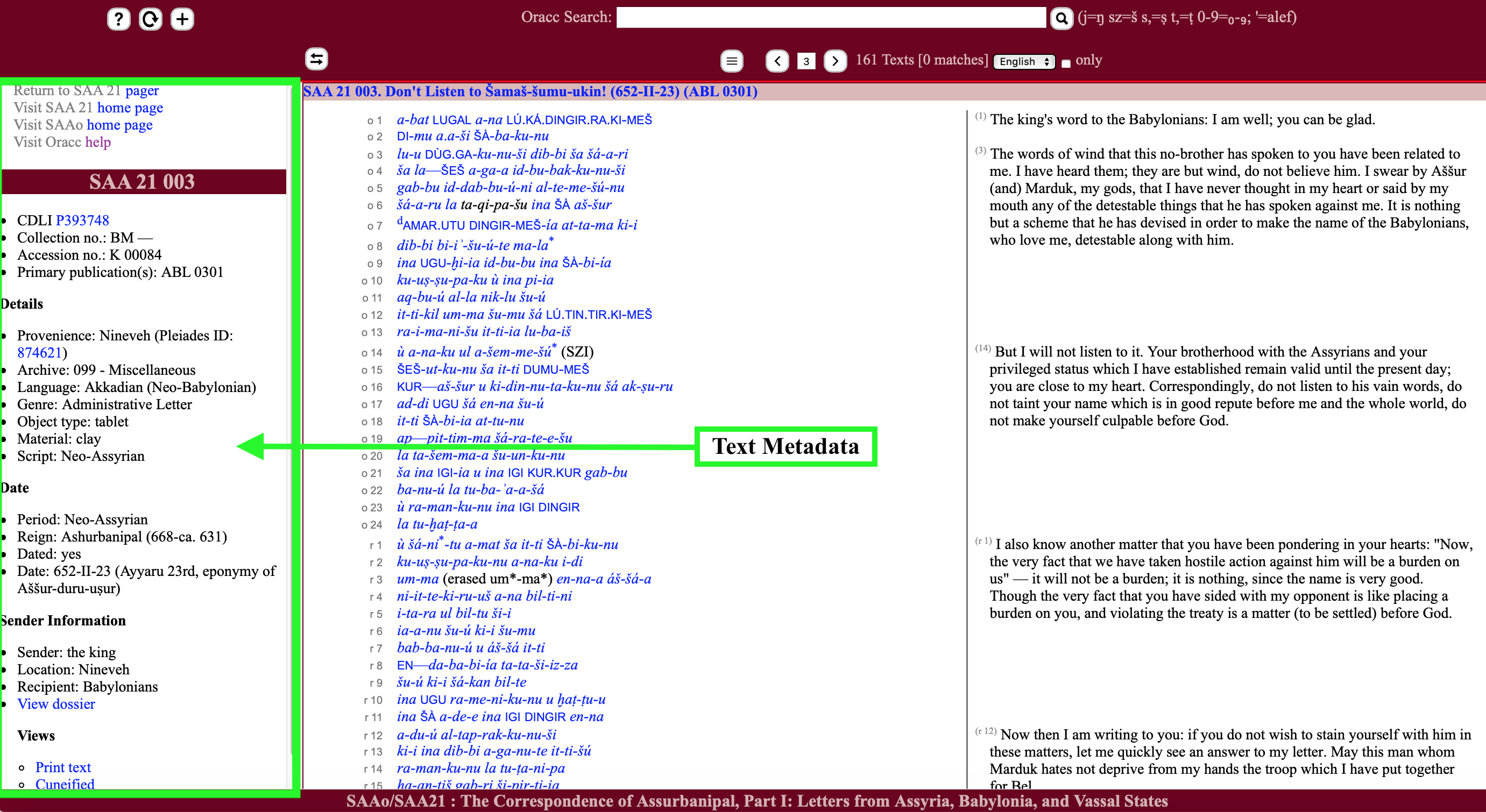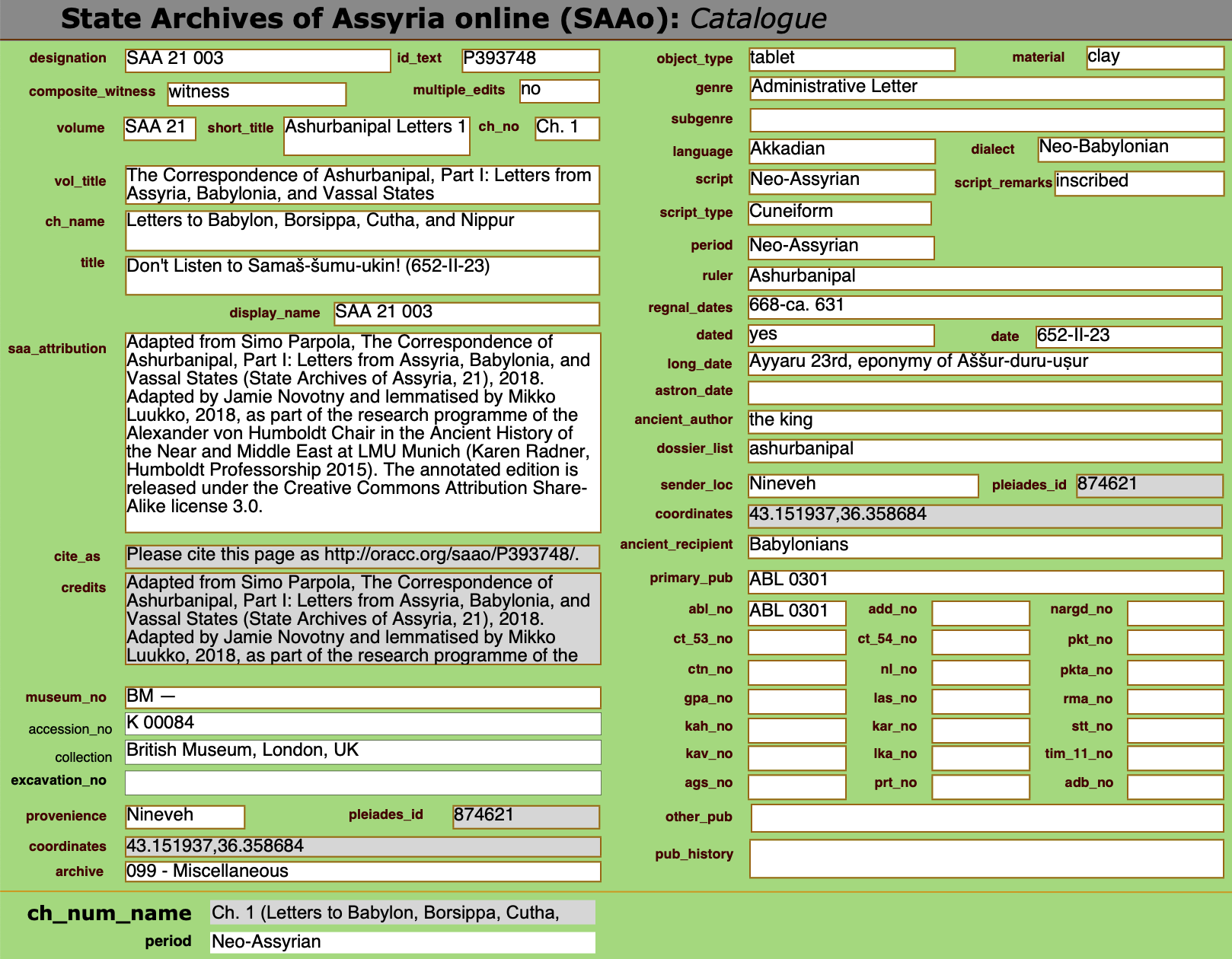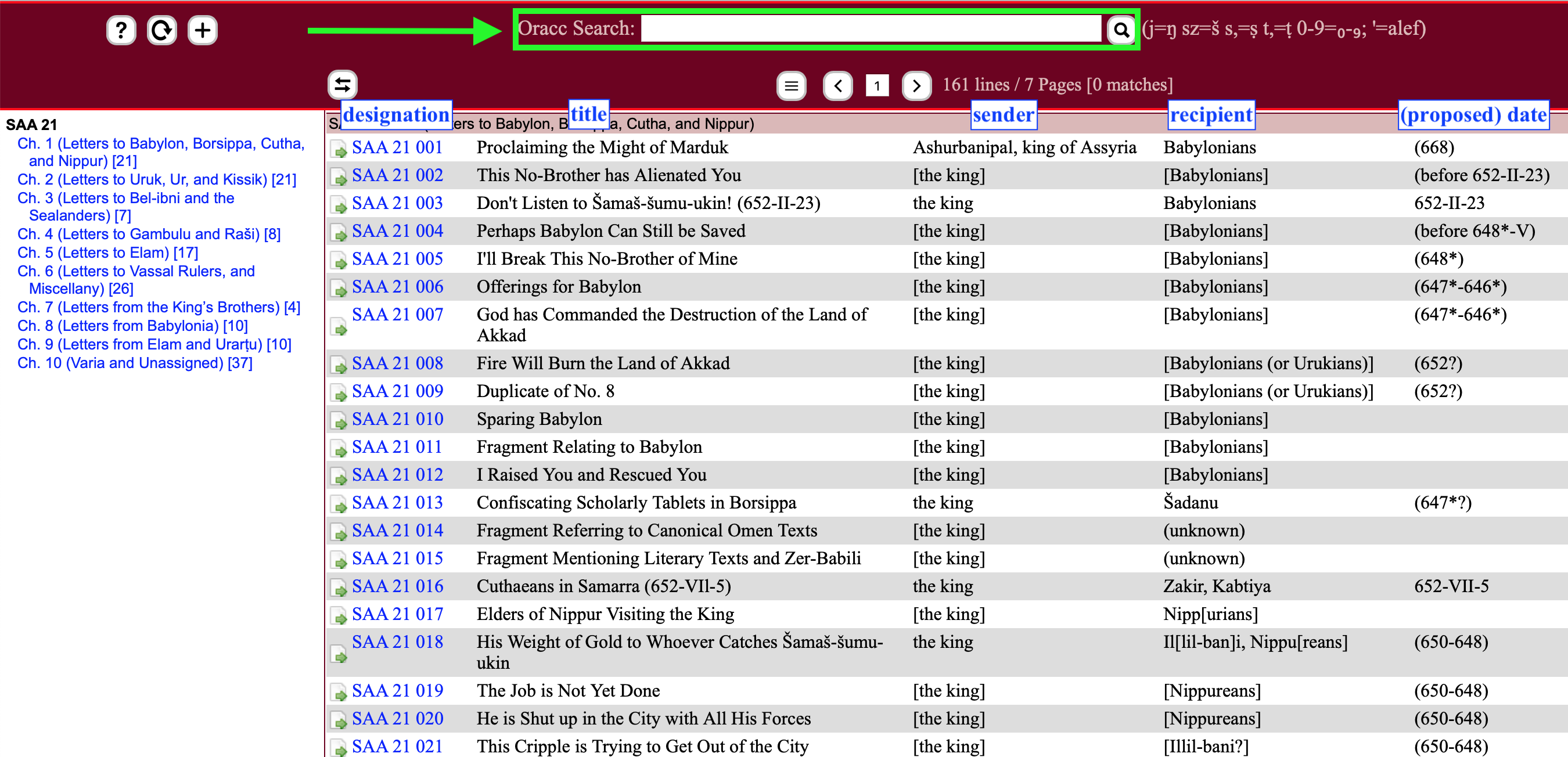Metadata View
To make the SAAo/SAA21 subproject more a little more user friendly, we have customized the metadata frame of the Item View (see the image below) so that more information about the texts included in this subproject are accessible to SAAo users. This page will give a brief overview of the information now provided in the metadata frame of the Item View.

General Information Links
This section contains four links:
- a link to return to the SAA 21 pager [/saao/saa21/pager];
- a link to the SAA 21 home page [/saao/saa21/];
- a link to main SAAo home page [/saao/]; and
- a link to the Oracc help pages [http://oracc.museum.upenn.edu/doc/help/index.html].
Designation
The text designation, which is displayed in the deep red background, comprises the SAA volume number (here, "SAA 21") and the text number within that publication (with leading zeros). For example, text 3 ("Don't Listen to Šamaš-šumu-ukin! (652-II-23) (ABL 0301)") has the designation "SAA 21 003."
Numbers
The numbers section displays the following information (when known):
- a hyperlinked CDLI number ("P" plus six digits), which loads the CDLI record for the object;
- the tablet's collection and accession number;
- the objects excavation number; and
- the text's primary publication(s) (usually the ABL or CT 54 number).
The collection, accession, and excavation numbers follow CDLI formatting. For example, K 84 (=SAA 21 003) displays as K 00984 (with two leading zeros). Leading zeros are also used for the primary publications. Thus, ABL 0301 for ABL 301.
Details
The details section contains general information about the text, including find spot, language (dialect), and material support. The metadata included here is:
- Provenience, with a link to the place resource on Pleiades [https://pleiades.stoa.org], a community-built gazetteer and graph of ancient places;
- the archival context of the find spot of the letter, if known;
- the language and dialect of the text (e.g., "Akkadian (Neo-Babylonian)");
- genre of the text (always "Administrative Letter");
- object type (always "tablet");
- material support (always "clay"); and
- script ("Neo-Assyrian" or "Neo-Babylonian").
Date
The date section includes the following information, when known:
- period (always "Neo-Assyrian");
- ruler and regnal dates, which is "Ashurbanipal (668-ca. 631)" for this SAAo subproject;
- a statement noting whether or not the letter is dated (= "dated: no" or "date: yes"); and
- the date of composition (if the letter is dated) or the date proposed by Simo Parpola in SAA 21 (if the letter is does not bear a date and if a date has been suggested).
For dated texts, the ancient date is given in both a short and long
format. The short format comprises (1) the year, (2) the month
(represented by uppercase Roman numerals), and (3) the day
(represented by numbers). For example, SAA 21 003 was written in
the Month of Ayyaru (II), 23rd
day, eponymy of Aššur-duru-uṣur, so that text's (short) date
is indicated as 652-II-23 in the SAAo/SAA21 pager [/saao/saa21/pager] (fifth column) and
in the metadata pane of that letter's Item View [/saao/saa21/P393748]. The long format, which
is only visible on the Item
View [/saao/saa21/P393748], gives (1) the ancient month name, (2) the day of the
month, and (3) the name of the eponym official during whose year the
text was written. For example, Ayyaru 23rd, eponymy of Aššur-duru-uṣur is the "long"
date for SAA 21 003.
For letters with partially preserved
dates, reconstructed text is included between square brackets; for
example, the partial date of SAA 21 063 is given as Ululu 16th, [eponymy of
Nabû-nadin-ahi]. On occasion, information has been supplied to
dated letters, usually texts bearing only the month (and day) of
composition. The supplemental information appears between parentheses.
For example, SAA 21 032 bears the date Addaru (II) 12th and, thus,
that date is rendered as
(646*)-XII-12 (or later) and Addaru 12th, (eponymy of Nabû-šar-ahhešu or later) since
the year is not recorded on the tablet itself.
As stated by Karen Radner in PNA 1/I (p. XVIII): "Whenever a text of
the Neo-Assyrian period mentions a date, it can be dated
absolutely. This fact ... is owed to the existence of a number of texts which list the
sequence of the eponymous officials who lent their names to the years
between 910 and 649. Unfortunately, no such list is known for the
years between 648 until the end of the empire. The reconstruction of
this sequence has long been a desideratum." For the so-called
post-canonical (PC) eponyms (from 648 until the end of the Assyrian
Empire), scholars generally place an asterisk (*) after the proposed year date; for example, 646* for the eponymy of Nabû-šar-ahhešu. Thus, following standard
Assyriological practice, an asterisk is given after the year for
the dates provided for the eponyms of the post-canonical period (beginning with
648). Further information can be found in the Post-canonical Eponyms [/saao/saas2/postcanonicaleponyms/index.html] chapter of the book Alan Millard (with a contribution by Robert Whiting), The Eponyms of the Assyrian Empire 910-612 BC (State Archives of Assyria Studies, 2) and in the introduction [http://oracc.museum.upenn.edu/rinap/rinap5/rinap51introduction/datingandchronology/eponymdates/index.html] of Jamie Novotny and Joshua Jeffers, The Royal Inscriptions of Ashurbanipal (668–631 BC), Aššur-etel-ilāni (630–627 BC) and Sîn-šarra-iškun (626–612 BC), Kings of Assyria, Part 1 (Royal Inscription of the Neo-Assyrian Period, 5/1).
For texts that are not dated (or whose dates are completely missing), proposed dates are displayed between parentheses in the SAAo/SAA21 pager [/saao/saa21/pager] (fifth column) and
in the metadata pane of the Item View [/saao/saa21/ P393831]. For example, SAA 21 022 is not dated, but Simo Parpola has suggested that that letter was written by the king (Ashurbanipal) to Nabû-ušabši in 650. Thus, the "date" of this non-dated letter is given as (650). In the Item View, the "Dated" metadata field of such texts will be displayed as Dated: no and state the date provided is the Proposed Date.
Note that the information provided for the "reign" is based solely on the information given for the "(proposed) date." For SAA 21, the reign will always be Ashurbanipal (668-ca. 631).
Sender Information
The sender information section contains the following:
- the name of the sender(s), when known;
- the (proposed) location of the sender(s);
- the name/title of the recipient of the letter, when known/preserved;
- a link to view the sender's dossier.
In the example shown in the screenshot above, the king (= Ashurbanipal) is the author of SAA 21 003. When one clicks on the "View dossier [/saao/saa21/ashurbanipal]" link in the metadata pane of that text, Oracc will load a new tab displaying the one hundred letters assigned to the Assyrian king in this SAA volume.
The names/titles of the sender and recipient are
displayed according to the information provided in the letters themselves. For example, the sender of SAA 21 003 [/saao/saa21/P393748] is the the king, while the recipients are the Babylonians. As for the (assumed) identity of "the king," this information is displayed in the "reign" field; since SAA 21 003 bears a date, it is certain that "the king" is Ashurbanipal, the last great king of Assyria. Partially preserved names contain square brackets, thereby showing how much of the names are actually preserved on the tablets and how much of the names are restored by modern scholars; for example, Il[lil-ban]i and the Nippu[reans] are the recipients of SAA 21 018 [/saao/saa21/P237945]. Fully restored names, which are (often) conjectural, appear entirely between square brackets; for example, [Sin-tabni-uṣur] is the restored and assumed recipient of SAA 21 041 [/saao/saa21/P393918].
The (sender) locations are assumed and they (generally) follow the
dossier assignments provided by the SAA authors. In the case of SAA
21, Nineveh, the
Assyrian administrative capital during the reign of Ashurbanipal, is
provisionally given as the sender's location when the letter is sent by Ashurbanipal, king of Assyria or the king.
Bibliography
When additional bibliography is included in SAA 21, those publications will be listed under the bibliography section. The abbreviations will be explained on the SAA 21 Abbreviations and Symbols [/saao/saa21/saa21abbreviationsandsymbols/index.html] page (in preparation).
Views
At present, two views of the text are possible:
- Print text, which allows users to print the transliteration and translation of the text; and
- Cuneified, which opens a new browser displaying the text in a computer-generated Neo-Assyrian font.
The SAAo/SAA21 catalogue has sixty-six searchable fields. These are:abl_no, accession_no, adb_no, add_no, ags_no, ancient_author, ancient_recipient, archive, astron_date, cdli_id, ch_name, ch_no, ch_num_name, collection, credits, ct_53_no, ct_54_no, ctn_no, date, designation, dialect, display_name, dossier_list, excavation_no, genre, gpa_no, has_date, id_text, kah_no, kar_no, kav_no, language, las_no, lka_no, long_date, material, museum_no, nargd_no, nl_no, object_type, other_pub, period, pkt_no, pkta_no, please_cite, pleiades_id, pleiades_sender_loc, primary_publication, prov_coordinates, provenience, prt_no, publication_history, regnal_dates, rma_no, ruler, script, script_remarks, script_type, sender_loc, sender_loc_coordinates, short_title, stt_no, subgenre, tim_11_no, title, vol_title, volume.

You can search any of these fields in the SAAo/SAA21 pager by using the Oracc Search window.

You can search the entire database or a specific field. To search the entire catalogue, enter catalogue: into the Oracc Search bar and the search criteria. For example, catalogue:Gambulu.

NOTE: If your search comprises more than one word, then use an underscore (_) instead of a blank space between the words. For example, catalogue:Kudurru_Urukians.

If you want to only search one field, enter the field name (without the underscrores) plus : and then the search criteria. For example, ancientauthor:Ea-zera-iqiša; ancientauthor:Ea-zera-iqisza (with sz instead of š) and ancientauthor:Eazeraiqisza (with sz instead of š and without hyphens) will also return results.

Jamie Novotny
Jamie Novotny, 'Metadata View', The Correspondence of Assurbanipal, Part I: Letters from Assyria, Babylonia, and Vassal States, SAA 21. Original publication:Winona Laka, IN, Eisenbrauns, 2018; online contents: SAAo/SAA21 Project, a sub-project of MOCCI, 2020 [http://oracc.org/saao/saa21/saa21metadataview/]